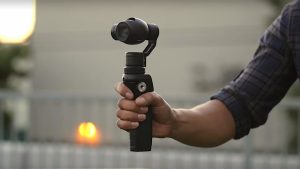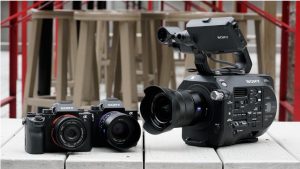Technology is constantly changing and getting better all the time; and camera equipment is no different.
Every year, more and more companies are coming up with innovative ways to pack more and more features into much smaller cameras. We’re also seeing other traditionally large and expensive camera equipment being made much smaller, more affordable and more accessible.
But does size matter when it comes to camera equipment? Well if you’ve just paid for a camera crew to come and film your corporate video, and they turn up with lots of bite-size camera equipment, you could be left feeling underwhelmed and, perhaps, overcharged.
A p rime example of this is the DJI Osmo. For those who don’t know, the DJI Osmo is a handheld gimbal system designed to capture slick and steady camera movements. To video production professionals, the DJI Osmo is considered a legitimate and useful piece of professional kit. However, the untrained eye would be forgiven for thinking that it may appear to be a bit amateurish. It’s small size and simplicity can certainly give that impression. Especially when you put it up against its bigger, more complicated-looking cousin: the DJI Ronin.
rime example of this is the DJI Osmo. For those who don’t know, the DJI Osmo is a handheld gimbal system designed to capture slick and steady camera movements. To video production professionals, the DJI Osmo is considered a legitimate and useful piece of professional kit. However, the untrained eye would be forgiven for thinking that it may appear to be a bit amateurish. It’s small size and simplicity can certainly give that impression. Especially when you put it up against its bigger, more complicated-looking cousin: the DJI Ronin.
 It’s the same with a lot of DSLR’s and other compact camera systems. It would be easy to assume that, on the face of it, cameras like the Panasonic GH4 or Sony A7S are the same as your consumer, point-and-shoot cameras. When the reality is that the GH4 and A7S can stand up pretty well to their bigger brothers, and they can produce some very high-quality imagery. When you look at the specs of these cameras, you’ll also see that they are some of the more superior ones on the market.
It’s the same with a lot of DSLR’s and other compact camera systems. It would be easy to assume that, on the face of it, cameras like the Panasonic GH4 or Sony A7S are the same as your consumer, point-and-shoot cameras. When the reality is that the GH4 and A7S can stand up pretty well to their bigger brothers, and they can produce some very high-quality imagery. When you look at the specs of these cameras, you’ll also see that they are some of the more superior ones on the market.
But that’s not to say that bigger cameras and bigger camera equipment is unnecessary overkill. Bigger video camera’s, like the Sony FS7, give you much more control over your images, allowing operators to adjust lots of different settings to achieve the right look. They also tend to have larger image sensors, which means that they can capture much higher resolution imagery with less visual noise.
Both sides of the argument have valid points. For us at Holler, we tend to use whatever is most suitable for the occasion. If the shoot requires us to be more mobile, then we would opt for more lightweight camera kit. We’d still be capturing great video, but it means we could get around a lot easier and save time when setting up the camera. But for most professional shoots, we’ll often opt for our larger cameras, because they offer more options and still shoot superior images and audio to the DSLR’s.
Want to see the kind of stuff that we produce with our wide range of camera equipment? Then check out our case studies.
